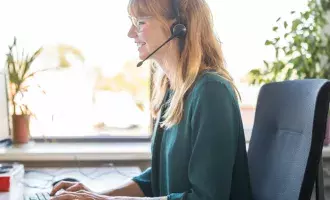Earlier this month I attended the Public Sector Networks Summit to talk about the potential of using the network as an enabler for new technology adoption. It’s a subject that I’m passionate about, when I look at the huge opportunity that lies in front of businesses and citizens today.
For many people, technology changed their working lives during the coronavirus pandemic. Overnight, they went from working in an office, on a corporate network, to working from home on a broadband connection using a VPN.
The emergence of the hybrid network
Now we have hybrid working, I firmly believe the hybrid network is the future, utilising the right technology for the right situation. We have had hybrid cloud for some time and the hybrid network is a natural follow-on that will enable our new ways of working.
What do I mean by a hybrid network? It’s a transport agnostic secure fabric that can be delivered using SD-WAN, internet, fibre, 5G, LoRa, or low earth orbit (LEO) satellites. And we are seeing increased need for secure fabric.
When I recently attended Connected Britain 2021, it was clear we are seeing the increasing adoption of full fibre infrastructure; accelerating the roll-out of fibre in regions that have previously had limited options when it comes to connectivity. Fibre will be integral to continued digital advancement of the UK, enabling the smart cities of the future, underpinning 5G mobile networks and driving smart technologies in the utilities and healthcare industries, to name just two.
CityFibre noted in a recent report that fibre will provide benefits that could total billions of pounds, from increased business productivity, flexible working, smart city infrastructure and 5G roll-out.
In the Highlands of Scotland, a fibre to the home roll-out has resulted in Inverness moving into the top 10 gigabit cities in the UK. It has also delivered significant inward investment from CityFibre and more internet providers are now operating in the region.
In East Renfrewshire, fibre to the home will cover 86% of the region. This is the highest to date in the UK and will reach some of the poorest connected and socially deprived parts of the region.
Where fibre isn’t available or would be too costly to roll out, we have Fixed Wireless Access (FWA). We are also now seeing LEO satellite connectivity becoming available for the more rural locations or to provide back up to 4G or 5G where required. The iPhone 13 is rumoured to have LEO satellite messaging bundled in, and Apple is even rumoured to be considering its own LEO satellite network.
When the government announced its levelling up agenda it said it was; “making the biggest changes to the way we support local economic growth in a decade”. A huge part of this involves regenerating town centres and supporting individuals into employment. The future network will support this by enabling flexible working and connecting people and devices to applications they need, whenever they need them, from wherever they are. It will deliver better citizen outcomes by improving connectivity, reducing digital exclusion and driving digital literacy. It can also increase access to services at home, such as eHealth. Importantly, it will help to retain and attract young people to the region by attracting innovative new companies and giving home workers better opportunities to work digitally. This is crucial because we need to see digital inclusion as a basic human right.
Enabling the internet of things
I also see the network as an enabler to create better outcomes for citizens through the adoption of the Internet of Things (IoT) and smart city technologies. In just a few years, IoT has gone from being a promising technology to becoming one of the most disruptive trends in technology today. It’s about finding new ways to collect data, make dumb devices smart, and create an ecosystem of devices that all communicate together across an organisation’s operations and services.
As IoT matures, the applications and benefits are almost endless. At Capita, we follow the 80/20 rule when it comes to building IoT solutions. 80% of the services we offer are off the shelf and based on known use cases that can be deployed to support challenges or requirements. Some examples are:
- Safety: Deploying lone worker and team working solutions in hazardous environments, using geolocation and geofencing boundaries, can help to identify when somebody steps into an area that is off limits. Monitors worn on the body sound an audible alarm or can vibrate to inform the wearer that they are somewhere that they shouldn’t be. Perfect for people who might be working in a new or unfamiliar environment.
- Society and the wellness of buildings: Sensor technology can detect environmental conditions that would encourage the formation of mould, therefore enabling a pro-active health, maintenance or advice response. Adding temperature monitoring could potentially help identify people at risk of fuel poverty during the winter months. Supporting the safe return of children to schools this September, across the UK we’re also seeing focus on CO2 monitoring, addressing concerns about ventilation across the education estate.
- Environment: Placing sensors near schools to monitor air quality can flag to parents on local signage that air quality is bad. This could encourage them to drop their children off a little further away and walk the rest of the journey. This not only improves air quality near the school, but also means the children and parents get some exercise in the process.
The remaining 20% of our solutions are bespoke and created in partnership with our clients to support their specific requirements. An example of this is in the Arbroath Basin, where some farmers in lower lying areas complained they were struggling to get enough water to irrigate their fields. This was due to excessive water extraction by neighbouring farmers higher up the river during dryer periods. We helped the Scottish Environmental Protection Agency to use river water level monitoring sensors to collect data in an effort to measure water extraction rates. They’re now able to consult and advise farmers on how to better manage their water extraction.
We are also providing technology to an NHS Trust that enables life-saving hospital equipment, such as ventilators, to be mapped digitally. The precise location of hospital equipment is logged in one centralised datapoint, which eliminates the need for fragmented electronic and paper records. This is delivered over the existing Wi-Fi network, making use of infrastructure that is already in place.
We make the Internet of Things the internet of purpose.

Ben Walker
Head of Sales - Digital Connectivity
Ben has worked in telecommunications for over 13 years, having held positions at both Virgin Media Business and Colt before joining Capita.For the past 5 years Ben has been working with the Public Sector delivering digital connectivity solutions that enable better citizen experiences.







